 |
| 1956: Inspection. Front to Rear: Lt. Cmdr Black, Chief Harkess, Chief Butch Buchanan (not certain). Sailors - front to rear: Jack Whitingham (from Westboro, Ottawa), ? Buregard (no first name), Ed Smith, unknown, unknown (Submitted by David Smith) |
 |
| 1956: Inspection. Front to Rear: Lt. Cmdr Black, Chief Harkess, Chief Butch Buchanan (not certain). Sailors - front to rear: Jack Whitingham (from Westboro, Ottawa), ? Buregard (no first name), Ed Smith, unknown, unknown (Submitted by David Smith) |
 |
| D.S.K Blackmore, with Master at Arms Bill Leggett, is making a presentation to a rate whose name is not known at this time. (From the collection of D.S.K. Blackmore submitted by Donna Loewen) |
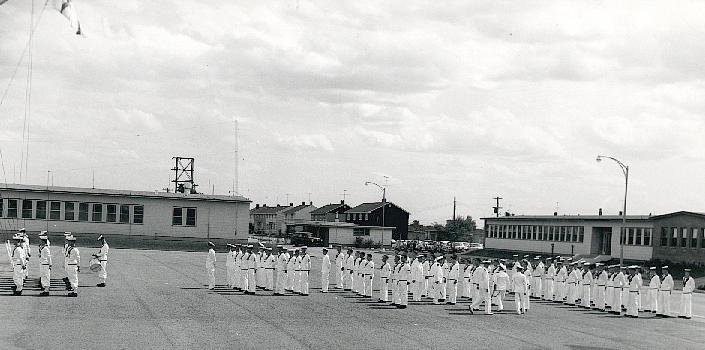 |
| Gloucester inspection. Year unknown. (From the collection of D.S.K. Blackmore submitted by Donna Loewen) |
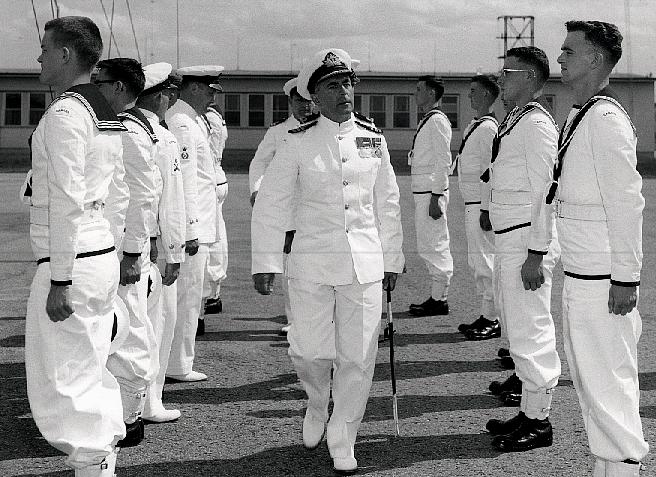 |
| 1956: D.S.K. Blackmore inspects the rates. (From the collection of D.S.K. Blackmore submitted by Donna Loewen) |
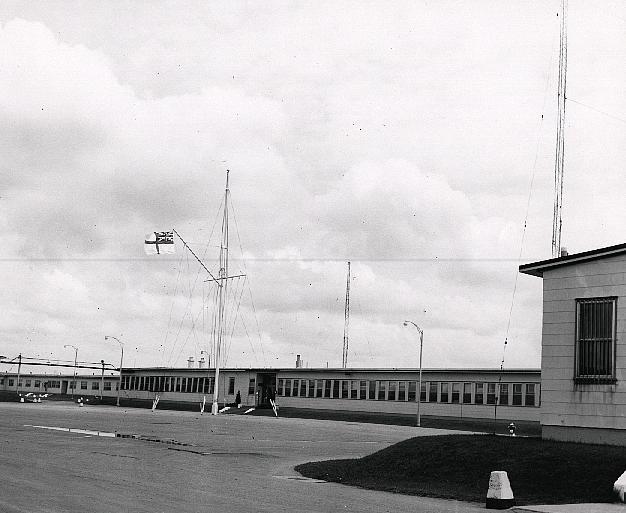 |
| 1956: Flag mast. (From the collection of D.S.K. Blackmore submitted by Donna Loewen) |
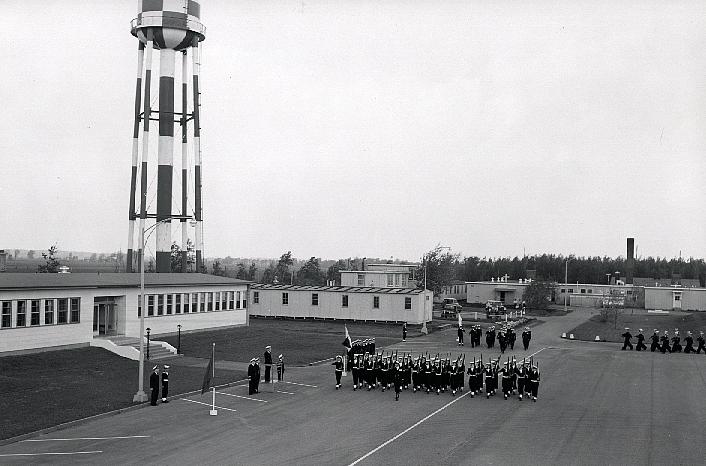 |
| March past. Year unknown. (From the collection of D.S.K. Blackmore submitted by Donna Loewen) |
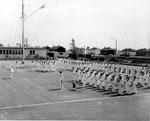 |
August 1957: Divisions at GLOUCESTER P1CS Burke is the photographer. (Photo # D9-H2 submitted by Spud Roscoe) |
 |
| Taken at 1957 Divisions: From (L-R): Lieutenant (SB) W.L.D. Davidson; Tulk; Lt. Swiniarski; Lafontaine and Wotherspoon (From the collection of D.S.K. Blackmore submitted by Donna Loewen) |
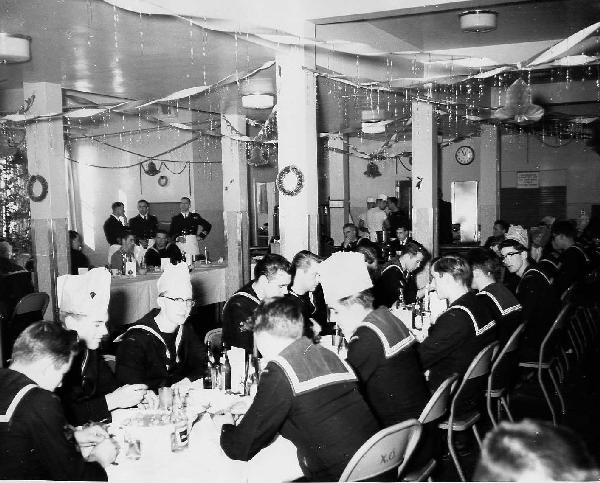 |
| 1957: Christmas dinner at Gloucester: It was a tradition that
the officers served Christmas dinner to the crew .
Most of this crew were posted to HMCS Coverdale after completion of their training and quite a few ended up marrying girls from Moncton, NB. At the left, wearing party hats are Cal Diamond and Mickey Marshall. Paul Campbell is the one wearing the party hat across from Mickey. (Photo by Ted Burke. Submitted by Spud Roscoe) |
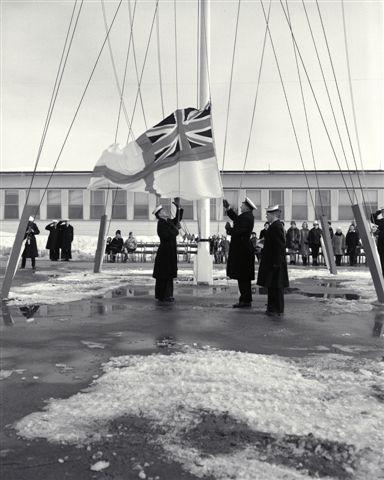 |
| The official ceremony inaugurating the new Canadian flag was held on
Parliament Hill in Ottawa on February 15, 1965, with Governor General Georges
Vanier, Prime Minister Lester B. Pearson, the members of the Cabinet and
thousands of Canadians in attendance. At HMCS Gloucester, the White Ensign
is being lowered for the last time and soon the Maple Leaf will replace
it. The Chief Petty Officer 1st Class lowering the White Ensign is Chief
J.A. (Bungy) Williams who was obviously very emotional on the occasion.
He was born in England, served in the RN and transferred to the RCN towards
the end of the war. Ordinarily it would be unheard of for such a senior
person to perform such a function, but he insisted and was allowed to retain
the Ensign on completion of the
event. (DND photo #O-15970 submitted by Ray White) |
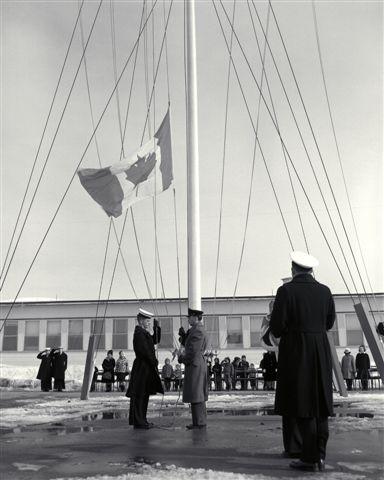 |
| With the raising of the Maple Leaf came the very first step in the
move towards unification in the Canadian Forces. Here, the new flag is
being raised by ABRS2 Roger Lambert and Ed Tucker, a Canadian Army Signal
Corps Signalman. Not seen in either of these two photos was
the ceremonial divisions, or a parade of the ship's company for this historic
occasion.
(DND Photo #O-15976 submitted by Ray White)
Ed Tucker also adds: " Another soldier had been picked to raise the flag but at the last moment could not. A Navy NCO came into the classroom where I was learning to type Morse Code and rushed me out. As we marched out on the parade square he was behind me instructing me what to do. I remember it well and the thing that scared me the most was that I might drop the flag - but all went well". |
 |
| This looks like calisthenics done on the spur of the moment. A regular exercise setup would not have people sweating away in uniforms, complete with neckties or cooks in their galley whites. The Officers' Wardroom Mess is the portion of the building which appears in the photo.The Chief's and PO's Mess is to the left and unseen. (From the collection of D.S.K. Blackmore submitted by Donna Loewen) |
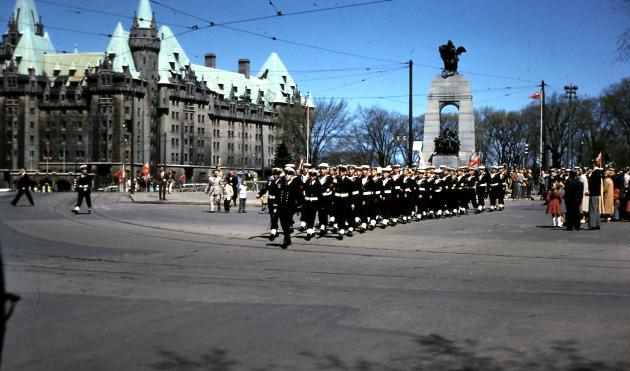 |
| Battle of the Atlantic Sunday, Ottawa 1958. This is undoubtedly the Gloucester contingent, the only regular RCN establishment within many, many miles. Until Unification, Gloucester was called on to provide representative platoons [1] for almost all public events in Ottawa. Reserve navy divisions, like HMCS Carleton etc, had a band but no regular force personnel who could carry off a parade such as Battle of the Atlantic Sunday or November 11th. (From the collection of D.S.K. Blackmore submitted by Donna Loewen) |
FOOTNOTES:[1] In February 1952, when the King died, Gloucester provided the naval contingent, Army units came from Borden and Petawawa, and RCAF units arrived from Trenton, Rockcliffe and Uplands. Regular Force RCN personnel at HMCS Bytown (otherwise known as Naval Headquarters) were not called upon to march.
Contributors and Credits: 1) Donna Loewen <donnaern(at)telus.net
2) Ray White <legerwhite(at)rogers.com>
3) David Smith <drdee(at)sympatico.ca>
4) Spud Roscoe <spudroscoe(at)eastlink.ca>
5) Ed Tucker <andraed(at)shaw.ca>
Feb 8/14